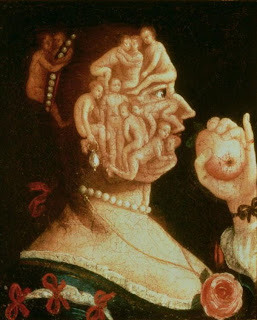Saturday, July 30, 2011
Giuseppe Arcimboldo
Giuseppe Arcimboldo
Giuseppe Arcimboldo (also spelled Arcimboldi) (1527 – July 11, 1593) was an Italian painter best known for creating imaginative portrait heads made entirely of such objects as fruits, vegetables, flowers, fish, and books — that is, he painted representations of these objects on the canvas arranged in such a way that the whole collection of objects formed a recognizable likeness of the portrait subject.
Giuseppe Arcimboldo Art
- Air
- Autumn
- Earth
- Fire
- Flora
- Portrait of Adam
- Portrait of Eve
- Spring
- Summer
- Summer-Portrait
- The Admiral
- The Cook
- The Cook 2
- The Gardener
- The Lawyer
- The Librarian
- The Sense of Smell
- Vertumnus
- Water
- Whimsical Portrait
- Winter
- Winter-Portrait
Giuseppe Arcimboldo Biography
In 1562 he became court portraitist to Ferdinand I at the Habsburg court in Vienna, and later, to Maximilian II and his son Rudolf II at the court in Prague. He was also the court decorator and costume designer. King Augustus of Saxony, who visited Vienna in 1570 and 1573, saw Arcimboldo's work and commissioned a copy of his "The Four Seasons" which incorporates his own monarchic symbols.
Arcimboldo's conventional work, on traditional religious subjects, has fallen into oblivion, but his portraits of human heads made up of vegetables, plants, fruit, sea creatures and tree roots, were greatly admired by his contemporaries and remain a source of fascination today. Art critics debate whether these paintings were whimsical or the product of a deranged mind. A majority of scholars hold to the view, however, that given the Renaissance fascination with riddles, puzzles, and the bizarre (see, for example, the grotesque heads of Leonardo da Vinci), Arcimboldo, far from being mentally imbalanced, catered to the taste of his times.
Arcimboldo died in Milan, to which he retired after leaving the Prague service. It was during this last phase of his career that he produced the composite portrait of Rudolph II (see above), as well as his self-portrait as the Four Seasons. His Italian contemporaries honored him with poetry and manuscripts celebrating his illustrious career.
When the Swedish army invaded Prague in 1648, during the Thirty Years' War, many of Arcimboldo's paintings were taken from Rudolf II's collection.
His works can be found in Vienna's Kunsthistorisches Museum and the Habsburg Schloss Ambras in Innsbruck, the Louvre in Paris, as well as numerous museums in Sweden. In Italy, his work is in Cremona, Brescia, and the Uffizi Gallery in Florence. The Wadsworth Atheneum in Hartford, Connecticut, the Denver Art Museum in Denver, Colorado, the Menil Foundation in Houston, Texas, the Candie Museum in Guernsey and the Real Academia de Bellas Artes de San Fernando in Madrid also own paintings by Arcimboldo.
Legacy
The bizarre works of Arcimboldo, especially his multiple images, were rediscovered in the early 20th century by Surrealist artists like Salvador Dalí. The exhibition entitled “The Arcimboldo Effect” at the Palazzo Grassi in Venice (1987) included numerous 'double meaning' paintings. Arcimboldo's influence can also be seen in the work of Shigeo Fukuda, István Orosz, Octavio Ocampo, and Sandro del Prete, as well as the films of Jan Švankmajer.
His painting, Water, was used as the cover of the album Masque by the progressive rock band Kansas.
A detail from Flora was used on the cover of the 2009 album Bonfires on the Heath by The Clientele.
The 'soup genie' character Boldo in the 2008 animated film The Tale of Despereaux, is composed of vegetables.
Arcimboldo's surrealist imagination is visible also in fiction. The first and last sections of 2666, Roberto Bolaño's last novel, concern a fictional German writer named Archimboldi, who takes his pseudonym from Arcimboldo.[citation needed]
The 1994 short story The Coming of Vertumnus by Ian Watson counterpoints the innate surrealism of the eponymous work against a drug-induced altered mental state.
Labels:
art,
artist,
Giuseppe Arcimboldo,
online art gallery,
paintings
Subscribe to:
Comments (Atom)









